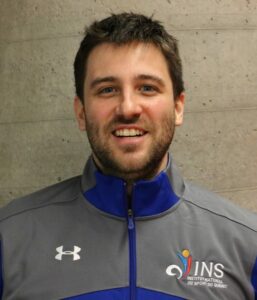The full paper can be found here.

Tell us more about yourself and the author team.
Félix Croteau is a sports physiotherapist working with the Canadian water polo players based out of the Institut National du Sport du Québec (INS Quebec). The INS Quebec is a service centre for elite level athletes, offering support for training and performance evaluations. A multidisciplinary team provides these services on-site and conducts research in injury prevention, concussions, and biomechanical and physiological markers of athletic performance. Félix is currently concluding a PhD at McGill University to manage risk factors for shoulder injuries in water polo.
Harry Brown is a strength and conditioning coach currently pursuing his graduate studies in biomechanics at McGill University. He has worked as a performance analyst with the Australian Sports Institute, where he was involved in biomechanical analysis for Cycling Australia. He was introduced to the research team via his membership in Dr Pearsall’s Ice Hockey Research Group (IHRG).
Dr David J Pearsall is an Associate Professor at McGill University’s Department of Kinesiology and Physical Education. His areas of expertise include biomechanics, human locomotion and applied ice hockey research.
Dr Shawn M Robbins is an Associate Professor at McGill University’s School of Physical and Occupational Therapy. He conducts research on the assessment of orthopaedic health conditions using biomechanical and clinical measures. Furthermore, he leads research groups on sports biomechanics, including ice hockey, soccer and water polo.
What is the story behind your study?
As part of our desire to provide the best possible care to our athletes, a thorough review of the literature on injuries in the sport of water polo and their underlying mechanisms was needed. This was done in the perspective of identifying areas that required more focus for the purpose of injury prevention, as well as those that need further research. Our initial observations were that there was a great focus on shoulder injuries specifically in this sport but that further data investigating other body areas or concussions were scarce. Therefore, we decided to aggregate this information more formally and to conduct a systematic review.
In your own words, what did you find?
Most of the injuries that occur during matches affect the head and the face. There is conflicting information about the incidence of concussions in this sport. Although survey data suggest that many players sustained this injury, cohort studies did not reveal the same findings. The shoulder area remains the target of most overuse injuries, with training volumes, flexibility, strength and scapular dyskinesia as the most often explored risk factors. Unfortunately, there were important differences in methods across studies, and a formal meta-analysis of the results was not possible. Further prospective research is necessary with this population to help better understand mechanisms of injury.
What was the main challenge you faced in your study?
To capture a broad range of injury types and locations, the criteria for the search needed to remain broader. We hesitated between adopting the style for a scoping review but ultimately focused on the research field and systematically reviewed the studies.